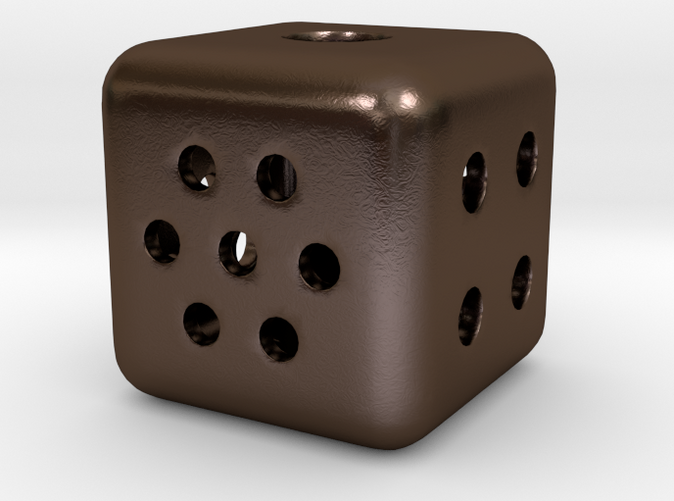This product is currently unavailable, waiting on Shapeways reenabling the ShapeJS customisation service.
If you'd like to order, contact Shapeways and tell them that you'd like to buy a ShapeJS2 product which is waiting to be switched on.
This is an extremely customisable 6-sided 'pip' (or 'spot') dice. Designed for printing in steel, it is hollow, with the pips connecting to the interior. The pips vary in size so that the same amount of material is removed from each face - therefore all dice produced ought to be 'fair' (see Fairness Testing, below).
The size is a 16x16x16 mm cube (except for the 'sharp' option, which is just over 15x15x15 mm)
Options are :
- choose how you'd like the edges smoothed
- for each face, choose any number of pips up to nine - many in several different formations.
- ensure that you have selected the surface finish you desire.
Please look at the images above for diagrams indicating the options available, or read further instructions below.
Edge Smoothing
There are four options:
- rounded - the edges and corners are all smoothed off
- bevelled - the edges and corners are clipped with a 45-degree slice.
- sphere - the die is smoothed as if it were inside a ball. The faces become circular.
- sharp - the die isn't smoothed at all, and remains a cube. (This form is slightly smaller than the others, as it has to use the same amount of material)
Pip numbers and formations
Pips are described using a number and an optional letter for each face.
The number indicates the number of pips, while the letter selects the formation.
The formations available are shown in a diagram in the images above.
If zero is entered, a large circle is drawn on the face, with the centre connected by eight bars.
The face descriptions are concatenated together to produce a 'pipstring' which describes the die.
Face order
Faces are represented in a particular order, which is equivalent to 1-2-3-4-5-6 on a standard 'anticlockwise', opposite-sides-sum-to-7 die.
If you imagine a die with one side squarely facing you, the order is top, front, right, left, back, base.
For orientation, if you imagine the net of that die unfolded with the front in the centre of a cross, with the back face on the right or left, then all faces are 'upright' (or if you prefer - in the default orientation).
For a clearer visual description please refer to the diagram in the images above.
Errors
If you don't include at least 6 numbers in the pipstring, then you will get an error, and no dice. If you use a number-letter formation which isn't recognised, that face will be drawn as if the letter was 'a'.
If you want a die with a zero on the first face, you
must include a letter somewhere in the pipstring for the die produced to be correctly specified. This is because the string won't be passed correctly if you use numbers alone. The work-around is to simply include a letter somewhere in the string.
If you would like a
similar die or dice in colourful plastic, I provide a solid version which is appropriate for that material, and rather cheaper. The solid version also allows several styles of pip, and would make a lovely (if expensive, and heavy) steel die.
Fairness Testing
I have printed this with rounded edges and pips '1a2a3a4a5a7a', and performed 606 rolls onto a hard surface. I used a chi-square test to look for bias. This did not indicate a significant difference from a fair die (P>0.05). Strictly speaking we fail to reject the null hypothesis that the die is fair.
(Why 606? I was intending to do 100 throws per side, but overshot, so continued to the next multiple of six.)
